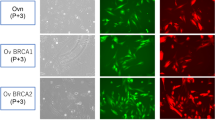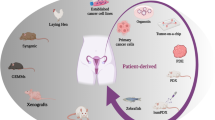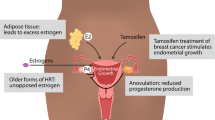Abstract
Purpose
Ovarian cancer is the leading cause of death from a gynaecological malignancy in the developed world, and is characterized by invasion and metastasis and thus causes a high fatality rate. Estrogen-related receptor alpha (ERRα) has been demonstrated to play a widespread and pathophysiological relevant role in tumourigenesis and development. The aim of this study was to investigate the effect of ERRα expression on the progression of ovarian cancer.
Methods
The correlation between ERRα expression level and clinical pathological parameters in ovarian cancer tissues were analysed via cancer public database CPTAC. The expression level of ERRα in ovarian cancer cells were confirmed by RT-qPCR and Western blot methods. The cellular ERRα expression was up-regulated by lentivirus transfection and down-regulated by specific antagonist. The invasion and metastasis capabilities of ovarian cancer cells were characterized by wound healing assay and trans-well chamber assay.
Results
The CPTAC database showed that the ERRα expression levels were higher in the late-stage and high-grade ovarian cancer tissues than in early-stage and low-grade tissues. Ovarian cancer cells with higher-expression ERRα exhibited stronger invasion and metastasis capabilities in vitro. After up-regulating the ERRα expression level, the invasion and metastasis capabilities of ovarian cancer cells were enhanced, while down-regulation weakened. Moreover, the wound sealing rate was positively correlated with the expression of ERRα mRNA expression level (r = 0.921, P < 0.01), and the cell invasiveness was also positively correlated with the cellular ERRα mRNA expression level (r = 0.926, P < 0.01).
Conclusions
Our results suggest that ERRα may promote the progression of ovarian cancer, and may serve as a promising predictive biomarker.






Similar content being viewed by others
Availability of data and materials
The datasets analyzed during the current study are available in the UALCAN database (http://ualcan.path.uab.edu).
Code availability
Not applicable.
References
Torre LA, Bray F, Siegel RL, Ferlay J, Lortet-Tieulent J, Jemal A (2015) Global cancer statistics, 2012. CA Cancer J Clin 65(2):87–108. https://doi.org/10.3322/caac.21262 (Epub 2015/02/06 PubMed PMID: 25651787)
Gentry-Maharaj A, Menon U (2012) Screening for ovarian cancer in the general population. Best Pract Res Clin Obstet Gynaecol 26(2):243–256. https://doi.org/10.1016/j.bpobgyn.2011.11.006 (Epub 2011/12/21 PubMed PMID: 22182415)
Giguère V, Yang N, Segui P, Evans RM (1988) Identification of a new class of steroid hormone receptors. Nature 331(6151):91–94. https://doi.org/10.1038/331091a0 (Epub 1988/01/07 PubMed PMID: 3267207)
Giguère V (2002) To ERR in the estrogen pathway. Trends Endocrinol Metab TEM 13(5):220–225. https://doi.org/10.1016/s1043-2760(02)00592-1 (Epub 2002/08/21 PubMed PMID: 12185669)
Tam IS, Giguère V (2016) There and back again: the journey of the estrogen-related receptors in the cancer realm. J Steroid Biochem Mol Biol 157:13–19. https://doi.org/10.1016/j.jsbmb.2015.06.009 (Epub 2015/07/08 PubMed PMID: 26151739)
Vargas G, Bouchet M, Bouazza L, Reboul P, Boyault C, Gervais M et al (2019) ERRα promotes breast cancer cell dissemination to bone by increasing RANK expression in primary breast tumors. Oncogene 38(7):950–964. https://doi.org/10.1038/s41388-018-0579-3 (Epub 2018/11/28 PubMed PMID: 30478447)
Yoriki K, Mori T, Kokabu T, Matsushima H, Umemura S, Tarumi Y et al (2019) Estrogen-related receptor alpha induces epithelial-mesenchymal transition through cancer-stromal interactions in endometrial cancer. Sci Rep 9(1):6697. https://doi.org/10.1038/s41598-019-43261-z (Epub 2019/05/02. PubMed PMID: 31040369; PubMed Central PMCID: PMCPMC6491648)
Valcarcel-Jimenez L, Macchia A, Crosas-Molist E, Schaub-Clerigué A, Camacho L, Martín-Martín N et al (2019) PGC1α suppresses prostate cancer cell invasion through ERRα transcriptional control. Cancer Res 79(24):6153–6165. https://doi.org/10.1158/0008-5472.Can-19-1231 (Epub 2019/10/09 PubMed PMID: 31594836)
Zhou Y, Jia Q, Meng X, Chen D, Zhu B (2019) ERRα regulates OTUB1 expression to promote colorectal cancer cell migration. J Cancer 10(23):5812–5819. https://doi.org/10.7150/jca.30720 (Epub 2019/11/19. PubMed PMID: 31737118; PubMed Central PMCID: PMCPMC6843886)
Zhang J, Guan X, Liang N, Li S (2018) Estrogen-related receptor alpha triggers the proliferation and migration of human non-small cell lung cancer via interleukin-6. Cell Biochem Funct 36(5):255–262. https://doi.org/10.1002/cbf.3337 (Epub 2018/06/05 PubMed PMID: 29862528)
Chen F, Chandrashekar DS, Varambally S, Creighton CJ (2019) Pan-cancer molecular subtypes revealed by mass-spectrometry-based proteomic characterization of more than 500 human cancers. Nat Commun 10(1):5679. https://doi.org/10.1038/s41467-019-13528-0 (Epub 2019/12/14. PubMed PMID: 31831737; PubMed Central PMCID: PMCPMC6908580)
Livak KJ, Schmittgen TD (2001) Analysis of relative gene expression data using real-time quantitative PCR and the 2(-Delta Delta C(T)) Method. Methods (San Diego, Calif) 25(4):402–408. https://doi.org/10.1006/meth.2001.1262 (Epub 2002/02/16 PubMed PMID: 11846609)
Sun P, Mao X, Gao M, Huang M, Chen L, Ruan G et al (2018) Novel endocrine therapeutic strategy in endometrial carcinoma targeting estrogen-related receptor α by XCT790 and siRNA. Cancer Manag Res 10:2521–2535. https://doi.org/10.2147/cmar.S168043 (Epub 2018/08/22. PubMed PMID: 30127640; PubMed Central PMCID: PMCPMC6089116)
Sun P, Xue L, Song Y, Mao X, Chen L, Dong B et al (2018) Regulation of matriptase and HAI-1 system, a novel therapeutic target in human endometrial cancer cells. Oncotarget 9(16):12682–12694. https://doi.org/10.18632/oncotarget.23913 (Epub 2018/03/22. PubMed PMID: 29560101; PubMed Central PMCID: PMCPMC5849165)
Lanvin O, Bianco S, Kersual N, Chalbos D, Vanacker JM (2007) Potentiation of ICI182,780 (Fulvestrant)-induced estrogen receptor-alpha degradation by the estrogen receptor-related receptor-alpha inverse agonist XCT790. J Biol Chem 282(39):28328–28334. https://doi.org/10.1074/jbc.M704295200 (Epub 2007/07/17 PubMed PMID: 17631492)
Nie Y, Wong C (2009) Suppressing the activity of ERRalpha in 3T3-L1 adipocytes reduces mitochondrial biogenesis but enhances glycolysis and basal glucose uptake. J Cell Mol Med 13(9b):3051–3060. https://doi.org/10.1111/j.1582-4934.2008.00382.x (Epub 2008/06/12. PubMed PMID: 18544047; PubMed Central PMCID: PMCPMC4516464)
Carnesecchi J, Vanacker JM (2016) Estrogen-related receptors and the control of bone cell fate. Mol Cell Endocrinol 432:37–43. https://doi.org/10.1016/j.mce.2015.07.019 (Epub 2015/07/25 PubMed PMID: 26206717)
Wang J, Wang Y, Wong C (2010) Oestrogen-related receptor alpha inverse agonist XCT-790 arrests A549 lung cancer cell population growth by inducing mitochondrial reactive oxygen species production. Cell Prolif 43(2):103–113. https://doi.org/10.1111/j.1365-2184.2009.00659.x (Epub 2010/05/08. PubMed PMID: 20447055; PubMed Central PMCID: PMCPMC6495589)
Deblois G, Giguère V (2013) Oestrogen-related receptors in breast cancer: control of cellular metabolism and beyond. Nat Rev Cancer 13(1):27–36. https://doi.org/10.1038/nrc3396 (Epub 2012/11/30 PubMed PMID: 23192231)
Senga S, Kawaguchi K, Kobayashi N, Ando A, Fujii H (2018) A novel fatty acid-binding protein 5-estrogen-related receptor α signaling pathway promotes cell growth and energy metabolism in prostate cancer cells. Oncotarget 9(60):31753–31770. https://doi.org/10.18632/oncotarget.25878 (Epub 2018/09/01. PubMed PMID: 30167092; PubMed Central PMCID: PMCPMC6114981)
Huang X, Wang X, Shang J, Zhaang Z, Cui B, Lin Y et al (2018) Estrogen related receptor alpha triggers the migration and invasion of endometrial cancer cells via up regulation of TGFB1. Cell Adhes Migr 12(6):538–547. https://doi.org/10.1080/19336918.2018.1477901 (Epub 2018/05/22. PubMed PMID: 29781387; PubMed Central PMCID: PMCPMC6363028)
Ding S, Tang Z, Jiang Y, Huang H, Luo P, Qing B et al (2017) IL-8 is involved in estrogen-related receptor α-regulated proliferation and migration of colorectal cancer cells. Digestive Dis Sci 62(12):3438–3446. https://doi.org/10.1007/s10620-017-4779-4 (Epub 2017/10/11 PubMed PMID: 28993941)
Lu D, Kiriyama Y, Lee KY, Giguère V (2001) Transcriptional regulation of the estrogen-inducible pS2 breast cancer marker gene by the ERR family of orphan nuclear receptors. Can Res 61(18):6755–6761 (Epub 2001/09/18 PubMed PMID: 11559547)
Chang CY, Kazmin D, Jasper JS, Kunder R, Zuercher WJ, McDonnell DP (2011) The metabolic regulator ERRα, a downstream target of HER2/IGF-1R, as a therapeutic target in breast cancer. Cancer Cell 20(4):500–510. https://doi.org/10.1016/j.ccr.2011.08.023 (Epub 2011/10/22. PubMed PMID: 22014575; PubMed Central PMCID: PMCPMC3199323)
Cai Q, Lin T, Kamarajugadda S, Lu J (2013) Regulation of glycolysis and the Warburg effect by estrogen-related receptors. Oncogene 32(16):2079–2086. https://doi.org/10.1038/onc.2012.221 (Epub 2012/06/06. PubMed PMID: 22665055; PubMed Central PMCID: PMCPMC3435484)
Jia Y, Sun R, Ding X, Cao C, Yang X (2018) Bisphenol S triggers the migration and invasion of pheochromocytoma PC12 cells via estrogen-related receptor α. J Mol Neurosci MN 66(2):188–196. https://doi.org/10.1007/s12031-018-1148-5 (Epub 2018/08/25. PubMed PMID: 30140998)
Lam SS, Mak AS, Yam JW, Cheung AN, Ngan HY, Wong AS (2014) Targeting estrogen-related receptor alpha inhibits epithelial-to-mesenchymal transition and stem cell properties of ovarian cancer cells. Mol Ther J Am Soc Gene Ther 22(4):743–751. https://doi.org/10.1038/mt.2014.1 (Epub 2014/01/15. PubMed PMID: 24419103; PubMed Central PMCID: PMCPMC3982489)
Funding
This research was funded by Fujian Provincial Maternity and Children’s Hospital Research Fund, YCXZ18-01.
Author information
Authors and Affiliations
Contributions
WH was a major contributor in writing the manuscript and performing the experiments. LC was a contributor in methodology and validation. PS was a contributor in conceptualization, supervision and funding acquisition. All authors read and approved the final manuscript.
Corresponding author
Ethics declarations
Conflict of interest
The authors declare that they have no competing interests.
Ethical approval
Not applicable.
Consent to participate
Not applicable.
Patient consent for publication
Not applicable.
Additional information
Publisher's Note
Springer Nature remains neutral with regard to jurisdictional claims in published maps and institutional affiliations.
Rights and permissions
About this article
Cite this article
Huang, W., Chen, L. & Sun, P. ERRα expression in ovarian cancer and promotes ovarian cancer cells migration in vitro. Arch Gynecol Obstet 305, 1525–1534 (2022). https://doi.org/10.1007/s00404-021-06323-0
Received:
Accepted:
Published:
Issue Date:
DOI: https://doi.org/10.1007/s00404-021-06323-0




